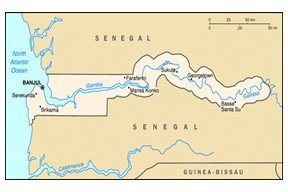Adapting agriculture to climate change: A case study of women vegetable producers in rural communities of the Gambia
Abstract
In Gambia, fruits and vegetable are the principal source of vitamins and minerals plays an important role in food, nutrition and income security of producers. Over the years’ climate change had an adverse effect on production and productivity of vegetables. The aim of the study was to address the problems faced by vegetable producers in relation to change using the climate smart agricultural technologies. The methodology of the study was random sampling administering semi-structure questionnaire, key informant interviews, and focus group discussion among producers. The finding showed that, onion registered 4000kg generating a net income of D196,000.00 followed by sweet pepper with net return of D112,000.00, however cabbage and bitter tomato there was no significant difference. Onion production was found to be the most outstanding commodity grown by women producer based on its comparative advantage. In addition, the second highest income earned was Gengi wollof’s with a net return of D707,616.00 thousand from vegetable production. Based, on the research findings I conclude that, crop diversification and intensification is the most effective and efficient resilient approach to mitigate the effects of climate change while increasing nutrition and income of vegetable producers. Therefore, recommends to government, partners, CSOs, and private sector to strengthening the capacity of women in the process of adapting and mitigating climate change related issues practicing climate smart agriculture.
Keywords:
Agriculture, Climate change, Rural communities, Vegetables, WomenDownloads
References
Abewoy, D. (2018). Review on impacts of climate change on vegetable production and its management practices. Advances in Crop Science and Technology, 6, 330, https://doi.org/10.4172/2329-000330
Adhikary, S., Koundinya, A. V. V., Pandit, M. K., & Bhattacharya, B. (2015). Evaluation of the efficiency of baby corn-based vegetable intercropping systems. International Journal of Plant and Soil Science, 5(6), 366–374.
Altieri, M.A., Nicholls, C.I., Henao, A., & Lana, M.A. (2015). Agro ecology and the design of climate change resilient farming systems. Agronomy and Sustainable Development, 35:869–890, https://doi.org/10.1007/s13593-015- 0285-2
Azumah, S. B., Adzawla, W., Osman, A., & Anani, P. Y. (2019). Cost-Benefit Analysis of On-Farm Climate Change Adaptation Strategies in Ghana. Ghana Journal of Geography, 12(1), 29- 46, https://doi.org/10.4314/gjg.v12i1.2
Bisbis, M. B., Gruda, N., & Blanke, M. (2018). Potential impacts of climate change on vegetable production and product quality- A review. Journal of Cleaner Production, 170, 1602-1620.
Climate-Smart Agriculture in Nepal, (2017). Available from: CSA_Profile_Nepal.pdf (worldbank.org).
Dhakal, R., Bhandari, S., Joshi, B., Aryal, A., Kattel, R. R., & Dhakal, S.C. (2019). Cost-benefit analysis and resource use efficiency of rice production system in different agriculture landscapes in Chitwan district, Nepal. Archives of Agriculture and Environmental Science, 4(4), 442-448, https://doi.org/10.26832/24566632.2019.0404011
Dhital, P., & Joshi, N. (2016). Factors affecting the adoption of recommended cauliflower production technology in Nepal. Turkish Journal of Agriculture-Food Science and Technology, 378-383.
FAO, (2016). A scheme and training manual on good agricultural practices (GAP) for fruits and vegetables. Bangkok: Food and agriculture organization of the United Nations, the regional office of Asia and the pacific.
Gairhe, J. J., & Adhikari, M. (2018). Intervention of climate smart agriculture practices in farmers’ field to increase production & productivity of winter maize in terai region of Nepal. Journal of the Institute of Agriculture and Animal Science, 35(1), 59-66, https://doi.org/10.3126 jiaas.v35i1.22514
G. C. A. (2015). APO ELearning Course on Good Agriculture Practice (GAP) for Greater Market Access.
Laosutsan, P., Shivakoti, G.P. & Soni, P. (2019). Factors influencing the adoption of good agricultural practices and export decision of Thailand’s vegetable farmers. International Journal of The Commons, 867–880.
Kunwar, B., Dhakal, D., & Panta, H.K. (2015). Determinants of smallholders’ adoption of off-season vegetable production technology in Okhaldhunga District of Nepal. Journal of the Institute of Agriculture and Animal Science, 221-228.
Kumar, P., Shehrawat, P., & Khan, M. (2017). Adoption Level of Masumbi (Citrus sinensis) Growers and its relationship with their personality traits in Haryana, India. Asian Journal of Agriculture Extension Economics and Sociology,1-6.
Pandey, G., Basnet, S., Panta, B., Bhattarai, K., Gyawali, B. & Tiwari, A. (2017). An Analysis of Vegetables and Fruits Production Scenario in Nepal. Asian Research Journal of Agriculture, 6(3), 1-10.
Parajuli, S., Poudel, P., & Neupane, H. (2018). Value Chain Analysis of Tomato in Chitwan District of Nepal. Acta Scientific Agriculture, 2(7), 113-116.
Paudel, B. Khanal, R.C., K.C, A., Bhatta, K., & Chauhary, P. (2017). Climate-smart agriculture in Nepal. Policy Brief, 1-12.
Poudel, P. (2020). Climate change and its impact on Nepalese Agriculture. Climate Change and its impact on Nepalese Agriculture – Climate Change and Nepal.
Rijal, S., & Rijal, B. (2019). Climate smart agriculture concept and adaptation in Nepal: An Overview. International Journal of Research & Review, 6(1), 47-56, https://www.ijrrjournal.com/IJRR_Vol.6_Issue.1_Jan2019.
Shirsath, P.B., Aggarwal, P.K., Thornton, P.K., & Dunnett, A. (2017). Prioritizing climate-smart agricultural land use options at a regional scale. Agricultural Systems, 151, 174-183, https://doi.org/10.1016/j.agsy.2016.09.018
Tal, A. (2018). Making Conventional Agriculture Environmentally Friendly: Moving beyond the Glorification of Organic Agriculture and the Demonization of Conventional Agriculture. Sustainability, 10, 1078, https://doi.org/10.3390/su10041078
Verma, A. K., Gurjar, P. S., Mishra, M., Jaiswal, R., & Punia, V. (2020). Impact Assessment of GAP adoption in augmenting mango growers’ income in Malihabad Uttar Pardesh. Indian Journal of Agricultural Sciences, 639-642.

Published
How to Cite
Issue
Section
Copyright (c) 2022 Agriculture and Environmental Science Academy

This work is licensed under a Creative Commons Attribution-NonCommercial 4.0 International License.

